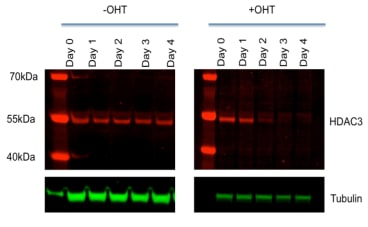Histone deacetylase 3 (HDAC 3) knockout mouse embryonic stem cell line
Invented by Shaun Cowley
Invented at University Of Leicester
- Datasheet
- References (2)
- Inventor Info
Info
| Catalogue Number | 158386 |
| Antigen/Gene or Protein Targets | Histone deacetylase 3 |
| Relevance | Responsible for the deacetylation of lysine residues on the N-terminal part of the core histones (H2A, H2B, H3 and H4). Histone deacetylation gives a tag for epigenetic repression and plays an important role in transcriptional regulation, cell cycle progression and developmental events. Histone deacetylases act via the formation of large multiprotein complexes. Histone deacetylase 3 (HDAC3) acts as the catalytic core of the SMRT/NCoR co-repressor complex which regulates chromatin structure and gene expression. It was recently shown that HDAC3 binds, and is regulated in vitro, by the binding of inositol phosphates (IP). |
| Production Details | E14 ES cells, expressing a CreER fusion protein from the ROSA26 locus, were used to generate HDAC3Lox/Lox; CreER cell lines by consecutive rounds of gene targeting. |
| Conditional | Yes |
| Conditional Description | Induction of Cre activity by addition of 4-hydroxy tamoxifen (OHT) to the growth media resulted in complete recombination of each allele and deletion of exon 2 (HDAC1Δ2/Δ2 or HDAC2 Δ2/Δ2) within 24 h |
| Research Area | Developmental Biology, Reproductive Biology |
| Notes |
Loss of exon 3 via the conditional KO disrupts the ORF of HDAC3 such that a premature stop codon is introduced. Following this deletion of exon 3 a further 4–5 days of culture are required before HDAC3 protein levels are reduced below 10% of those of control cells. "Loss of HDAC3 does not cause a significant reduction in total deacetylase activity with only minor changes in the acetylation levels of histones. However, the proliferative capacity of knockout cells is inhibited with a delay in cell doubling time. Upon differentiation, embryoid bodies (EBs) lacking HDAC3 are significantly smaller and morphologically different compared to controls. Microarray analysis over a 7-day time course of EB differentiation reveals that endodermal cell markers are over-expressed at both early and late stages of development, suggesting that HDAC3 plays an important role in regulating gene expression during embryonic development." From ANALYSIS OF THE PHYSIOLOGICAL ROLE OF HISTONE DEACETYLASE 3 (HDAC3) AND ITS REGULATION BY INOSITOL PHOSPHATES by Lyndsey Claire Wright, PhD Thesis, University of Leicester, June 2017 |
References: 2 entries
ANALYSIS OF THE PHYSIOLOGICAL ROLE OF HISTONE DEACETYLASE 3 (HDAC3) AND ITS REGULATION BY INOSITOL PHOSPHATES
Simandi et al. 2016. Mol Cell. 63(4):647-661. PMID: 27499297.
Add a reference
References: 2 entries
ANALYSIS OF THE PHYSIOLOGICAL ROLE OF HISTONE DEACETYLASE 3 (HDAC3) AND ITS REGULATION BY INOSITOL PHOSPHATES
Simandi et al. 2016. Mol Cell. 63(4):647-661. PMID: 27499297.
Add a reference
Inventor Information
Inventors

|
Shaun Cowley |





